Wart Remedy Selection Tool
Personalized Remedy Selection
Select your skin type, wart location, and previous treatment experience to find the most suitable natural remedy for your situation.
Recommended Remedy
Warts can be a pesky nuisance, and many people wonder if there’s a gentler way to make them disappear without a trip to the doctor. This guide breaks down the science behind natural wart remedies, examines how well they work, and flags any safety concerns you should know before reaching for that kitchen cabinet.
What Causes a Wart?
Wart is a small, rough growth on the skin caused by an infection with the human papillomavirus (HPV). The virus invades the top layer of skin, prompting cells to multiply rapidly and form the characteristic bump. Most warts are harmless, but they can be painful, especially when located on the hands or feet, and they may spread to other skin areas or people.
The specific strain of human papillomavirus is a DNA virus with over 100 types, some of which target skin cells and produce warts. While the immune system usually clears the virus over time, a weakened response can let the wart linger for months or even years.
How Do Natural Remedies Work?
Most plant‑based or household solutions aim to achieve one of three things: destroy the virus, soften the wart tissue, or stimulate a local immune response. The active compounds often have antiviral, keratolytic (skin‑peeling), or anti‑inflammatory properties.
For example, essential oils contain terpene molecules that can break down the protein matrix holding the wart together, while acidic liquids lower the skin’s pH, making the wart environment hostile for the virus.
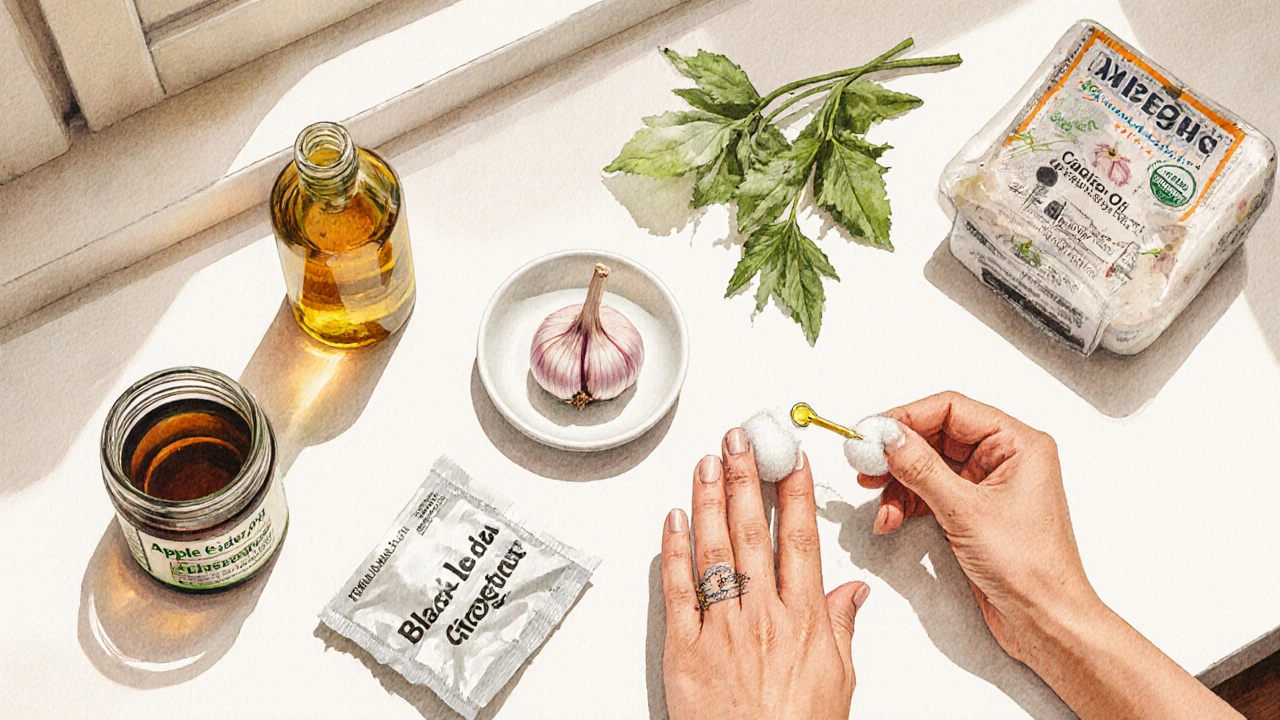
Top Natural Remedies and What the Evidence Says
-
Tea tree oil is an essential oil from Melaleuca alternifolia, rich in terpinen-4-ol and known for antiviral and anti‑inflammatory effects. Apply a few drops to the wart twice daily, covering with a bandage. Small case series report clearance rates of 50‑70% after 4‑6 weeks, though larger trials are still lacking.
-
Apple cider vinegar is a fermented solution containing acetic acid, which creates a low‑pH environment that can dissolve wart tissue. Soak a cotton ball in the vinegar, secure it on the wart, and leave it overnight. A 2018 pilot study noted a 60% success rate after eight weeks, but skin irritation is common.
-
Garlic is a bulb rich in allicin, a compound with antiviral and keratolytic activity. Crush a clove, apply the paste, and cover for several hours daily. Anecdotal reports suggest 40‑55% clearance within a month, with occasional burning sensations.
-
Dandelion latex is a milky sap rich in a proteolytic enzyme that can break down wart tissue. Collect fresh latex, dab it on the wart, and repeat every night. Small clinical observations report around 45% effectiveness after six weeks.
-
Black salve is a traditional, plant‑based ointment usually containing bloodroot and zinc chloride, designed to necrotize skin lesions. Apply a thin layer once daily. Because it can damage healthy skin, professional guidance is strongly advised; success rates vary widely.
-
Salicylic acid (from willow bark) is a keratolytic agent that softens the outer skin layer, allowing the wart to slough off. Over‑the‑counter preparations typically contain 17‑40% acid. When used correctly, clearance can reach 70‑80% after 8‑12 weeks.
Safety Considerations
Natural doesn’t automatically mean safe. Here are the main pitfalls:
- Skin irritation or chemical burns - especially with acidic solutions like apple cider vinegar or potent oils.
- Allergic reactions - essential oils and latex can trigger contact dermatitis.
- Incorrect application - using too much or leaving a remedy on for too long can damage surrounding healthy tissue.
- Underlying health conditions - people with weakened immune systems, diabetes, or peripheral circulation issues should consult a clinician before self‑treating.
Always do a patch test: apply a tiny amount of the remedy on the inner forearm, wait 24 hours, and check for redness, itching, or swelling before treating the wart.
Natural Remedies vs. Conventional Treatments
| Remedy | Active Ingredient | Typical Success Rate | Common Side Effects | Usage Tips |
|---|---|---|---|---|
| Tea Tree Oil | Terpinen‑4‑ol | 50‑70% (4‑6weeks) | Local irritation, dryness | 2drops, twice daily, covered |
| Apple Cider Vinegar | Acetic Acid | ≈60% (8weeks) | Burning, skin discoloration | Overnight soak, protect surrounding skin |
| Garlic Paste | Allicin | 40‑55% (4weeks) | Burning, odor | Crush fresh clove, apply 3‑4hrs |
| Dandelion Latex | Proteolytic Enzyme | ≈45% (6weeks) | Minor redness | Fresh latex nightly |
| Black Salve | Bloodroot, Zinc Chloride | Variable (30‑80%) | Scarring, tissue loss | Apply thin layer, monitor closely |
| Salicylic Acid (Willow Bark) | Salicylate | 70‑80% (8‑12weeks) | Dryness, mild pain | Daily filing, keep moist |
| Cryotherapy (Liquid Nitrogen) | Extreme Cold (‑196°C) | 85‑95% (1‑2sessions) | Blistering, pigment change | Professional administration only |
The table shows that while some natural options achieve respectable clearance rates, they often require longer treatment periods and carry a higher risk of skin irritation compared with clinically administered cryotherapy.
When to See a Professional
If a wart:
- Is bleeding heavily or ulcerated,
- Changes color or shape rapidly,
- Causes significant pain despite home care,
- Appears on the face, genitals, or under a nail,
- Persists after three months of diligent natural treatment,
schedule a dermatologist visit. Professional options include cryotherapy, laser ablation, or prescription‑strength salicylic acid, which can speed up resolution and reduce scarring risk.
Putting It All Together: A Simple Home Plan
- Choose a remedy that suits your skin type - start with tea tree oil if you have sensitive skin, or apple cider vinegar if you tolerate acidity.
- Perform a 24‑hour patch test.
- Clean the wart and surrounding area with mild soap and let it dry.
- Apply the selected remedy according to the usage tips in the table.
- Cover with a breathable bandage to keep the area moist and protected.
- Track progress in a journal - note any redness, pain, or size reduction.
- If no improvement after 8‑12 weeks, consult a healthcare professional.
Frequently Asked Questions
Can warts disappear on their own?
Yes, many warts resolve without treatment in 2‑3years as the immune system clears the HPV infection. However, this can be a slow process, and some people prefer active removal.
Is it safe to use multiple natural remedies at once?
Combining treatments can increase irritation. It’s best to trial one remedy at a time, assessing tolerance before adding another.
How long does it usually take to see results?
Most natural options need 4‑12weeks of consistent use. Some users notice softening within a couple of weeks, while complete clearance may take longer.
Are there any warts that should never be treated at home?
Warts on the genitals, around the eyes, or under nails are best evaluated by a clinician. Improper home treatment can cause infection or permanent damage in these areas.
Do natural remedies prevent new warts from forming?
Most natural treatments target existing lesions; they don’t boost systemic immunity. Maintaining good hand hygiene and avoiding shared surfaces reduces the chance of new infections.
Natural remedies can be a convenient first step for many people dealing with warts. By understanding how each option works, watching for side effects, and knowing when professional help is needed, you’ll be better equipped to make a safe, effective choice.
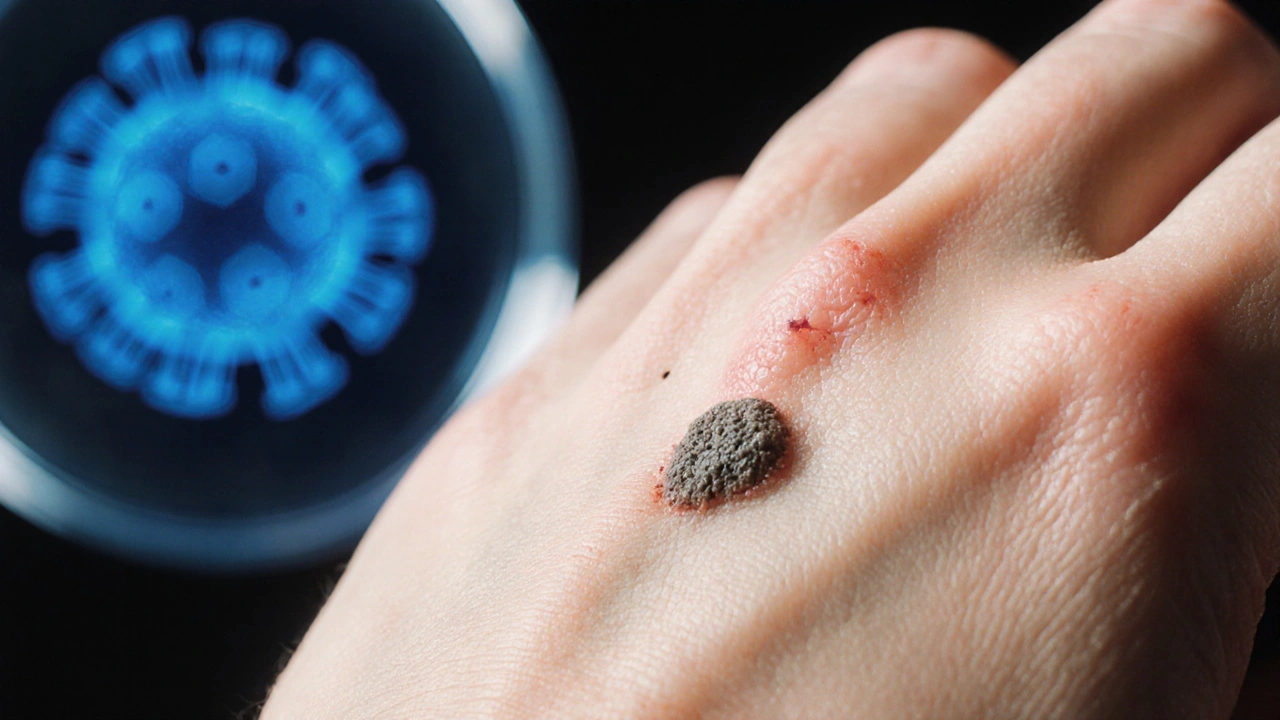
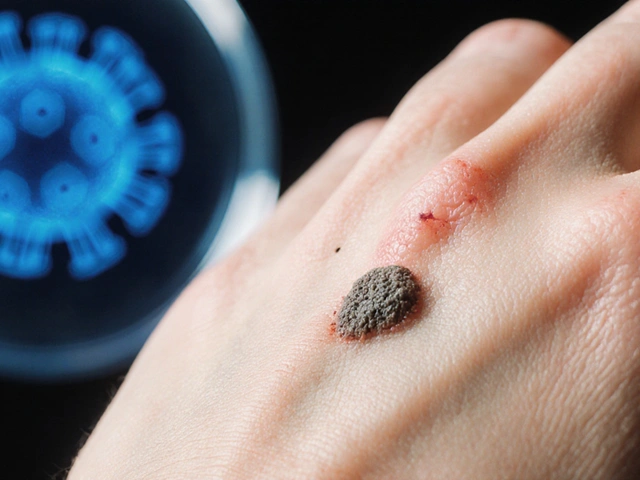

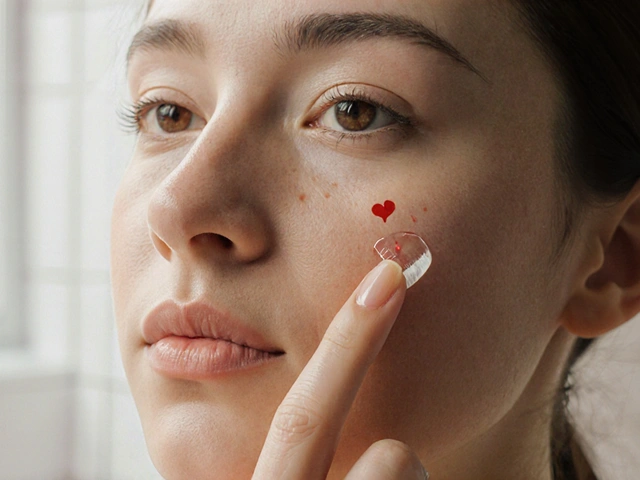


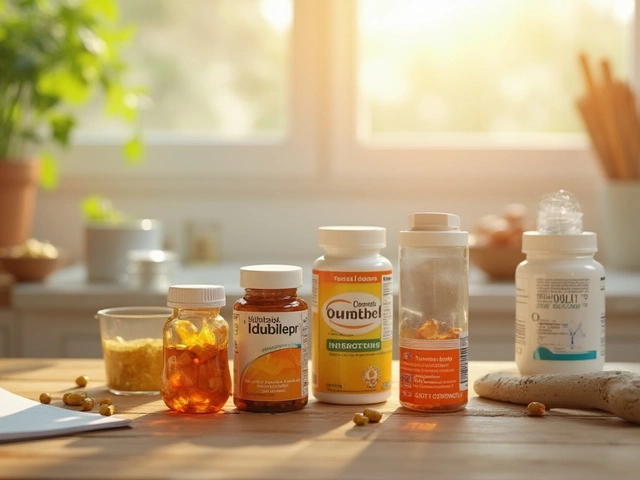
Carissa Engle
October 12, 2025 AT 04:05Warts are caused by a virus that loves to hijack the top layer of skin and then churn out that rough bump that most of us dread. The guide you posted does a decent job of enumerating the most popular home‑grown options like tea tree oil, apple cider vinegar, and garlic paste. It also mentions the scientific reasoning behind each remedy such as antiviral terpinen‑4‑ol in tea tree or the low pH of vinegar that can dissolve wart tissue. What many people ignore is the importance of the immune system in actually clearing the HPV infection that underlies the growth. The patch test advice is solid because even natural compounds can irritate sensitive skin or cause dermatitis. A tip that often gets lost is the role of regular exfoliation to keep the wart surface soft and receptive to treatment. Consistency is key; applying a remedy twice a day for weeks is not a hobby project but a disciplined regimen. Remember to keep the surrounding skin protected with a bandage to avoid acid burns from vinegar. If you choose garlic, be prepared for a pungent odor that can linger on clothing for days. Dandelion latex is an obscure option but the proteolytic enzyme can be effective when harvested fresh. Black salve carries the highest risk of scarring and should only be used under professional supervision. Salicylic acid remains the gold standard among over‑the‑counter products and approaches the success rates of medical options. For people with diabetes or poor circulation, any self‑treatment on the feet should be discussed with a doctor first. The guide correctly advises seeking professional help for genitals, under nails, or rapidly changing lesions. Overall the information is useful but readers must balance patience with safety to avoid turning a simple wart into a larger skin issue.
Darius Reed
October 20, 2025 AT 08:00I read the article and it really got me thinkin about tryin some of tho home remedies. I defnitely will give the apple cidr vinegar a shot even if it might burn a bit. The tip about patch testing is good but I hope it wont be to painful. I also like the idea of using garlick paste but the smell is sooo strong. Overall it's a good steer for anyone who wants a cheap alternative.
Karen Richardson
October 28, 2025 AT 10:54The information presented is largely accurate, though a few clarifications are warranted. First, while tea tree oil exhibits antiviral properties, its efficacy varies significantly across HPV strains. Second, the success rates cited for apple cider vinegar stem from small pilot studies and should be interpreted with caution. Third, the recommendation to apply garlic paste for "3‑4 hours daily" may be excessive for sensitive skin; a shorter exposure often suffices. Additionally, the table omits the standard concentration guidelines for over‑the‑counter salicylic acid preparations, which are essential for safe use. Finally, the warning about scarring from black salve is appropriate, but the phrase "professional guidance is strongly advised" could be expanded to specify dermatological supervision.
AnGeL Zamorano Orozco
November 5, 2025 AT 14:49Okay, let me set the record straight because this whole natural wart saga is blown out of proportion. First off, tea tree oil is not some miracle cure; it can irritate your skin harder than a bad breakup. Second, apple cider vinegar will melt your skin if you leave it on too long – you might as well be using lava. Third, garlic paste? Yeah, it smells like a vampire's breath and will burn you like a cheap barbecue. And don’t even get me started on dandelion latex – you have to pull fresh sap out of a weed, which is a nightmare in itself. The guide tries to sound scientific but drops more facts than a broken faucet. If you want to waste weeks on home concoctions, go ahead, but don’t blame the internet when you end up with a scarred hand.
Cynthia Petersen
November 13, 2025 AT 18:43Wow, the guide really pulls out the big guns with all those natural options – must be nice to have a kitchen full of miracle cures. I guess if you love the smell of stale vinegar and garlic breath, you’re all set. The table is nice and tidy, though I’m still curious why we’re not just buying a cheap OTC salicylic acid and calling it a day. Anyway, good luck to anyone who decides to turn their bathroom into a wart‑war zone.
Marcia Hayes
November 21, 2025 AT 22:38Thanks for the roundup, Cynthia! I’ll stick to the apple cider vinegar because I’m not into the whole garlic breath thing. I’ll be sure to do the patch test you mentioned and keep the area clean. Wish me luck – hope the wart disappears without a drama.
Danielle de Oliveira Rosa
November 30, 2025 AT 02:33It’s interesting how our bodies negotiate with viruses in the skin, almost like a quiet dialogue. When we apply a remedy, we’re essentially nudging that conversation toward resolution. Patience, as you noted, is a form of respect for the healing process. I appreciate the encouragement to keep a journal; tracking changes can reveal subtle patterns. In the end, whether natural or clinical, the goal is a harmonious skin landscape.
Tarun Rajput
December 8, 2025 AT 06:27Esteemed readers, the comprehensive nature of this guide warrants a methodical appraisal. Firstly, the taxonomy of natural wart remedies is delineated with commendable clarity, encompassing both phytochemical agents and acidic solutions. Secondly, the biochemical mechanisms – antiviral terpinen‑4‑ol, keratolytic salicylic acid, osmotic disruption via acetic acid – are expounded with sufficient granularity to satisfy a scholarly curiosity. Thirdly, the risk assessment framework, emphasizing patch testing and the avoidance of treatments on compromised dermal regions, reflects prudent clinical judgment. Fourth, the comparative table synthesizes efficacy data, albeit derived from limited sample sizes, thereby offering a heuristic rather than an absolute metric. Fifth, the protocol for progressive monitoring, wherein patients maintain a log of lesion dimensions and subjective discomfort, aligns with evidence‑based practices for longitudinal assessment. Sixth, the cautionary guidance regarding immunocompromised individuals and diabetics underscores a necessary vigilance. Seventh, the recommendation to seek professional intervention for genital, peri‑ungual, or rapidly evolving warts adheres to best practice standards. Eighth, the discourse on the psychosocial implications of warts, though brief, acknowledges the broader impact on quality of life. In conclusion, the guide serves as a valuable adjunct for both laypersons and clinicians seeking a nuanced understanding of home‑based wart management.